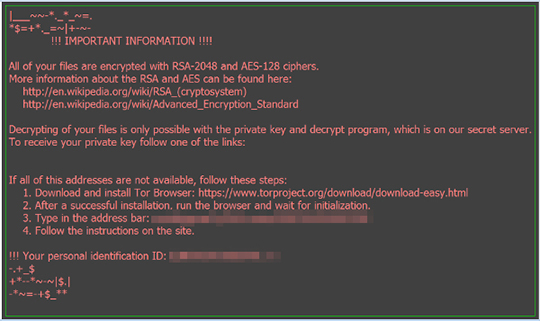RANSOM_LOCKY.AES
Trojan-Ransom.Win32.Locky.wbm (Kaspersky), Ransom:Win32/Locky (Microsoft)
Windows


Threat Type: Trojan
Destructiveness: No
Encrypted: Yes
In the wild: Yes
OVERVIEW
Downloaded from the Internet
This Trojan modifies the Internet Explorer Zone Settings.
It connects to certain websites to send and receive information.
TECHNICAL DETAILS
286,720 bytes
, DLL
No
21 Nov 2016
Drops files, Encrypts files
Installation
This Trojan drops the following component file(s):
- %Desktop%\-INSTRUCTION.html - ransom note
- %Desktop%\-INSTRUCTION.bmp - image used as wallpaper
- {folders containing encrypted files}\_[number]-INSTRUCTION.html - ransom note
(Note: %Desktop% is the desktop folder, where it usually is C:\Documents and Settings\{user name}\Desktop in Windows 2000, Windows Server 2003, and Windows XP (32- and 64-bit); C:\Users\{user name}\Desktop in Windows Vista (32- and 64-bit), Windows 7 (32- and 64-bit), Windows 8 (32- and 64-bit), Windows 8.1 (32- and 64-bit), Windows Server 2008, and Windows Server 2012.)
Web Browser Home Page and Search Page Modification
This Trojan modifies the Internet Explorer Zone Settings.
Other Details
This Trojan connects to the following website to send and receive information:
- {random}.su
- {random}.org
- {random}.work
- {random}.click
- {random}.info
It encrypts files with the following extensions:
- .7zip
- .SQLITE3
- .SQLITEDB
- .accdb
- .accde
- .accdr
- .accdt
- .agdl
- .aiff
- .aspx
- .asset
- .back
- .backup
- .backupdb
- .bank
- .blend
- .cdr3
- .cdr4
- .cdr5
- .cdr6
- .cdrw
- .class
- .config
- .contact
- .craw
- .d3dbsp
- .db_journal
- .ddoc
- .ddrw
- .design
- .djvu
- .docb
- .docm
- .docx
- .dotm
- .dotx
- .erbsql
- .flac
- .flvv
- .forge
- .gray
- .grey
- .groups
- .html
- .ibank
- .incpas
- .indd
- .java
- .jpeg
- .kdbx
- .kpdx
- .laccdb
- .lay6
- .litemod
- .litesql
- .m2ts
- .mapimail
- .moneywell
- .mpeg
- .ms11
- .ms11 (Security copy)
- .nvram
- .onetoc2
- .pages
- .plus_muhd
- .potm
- .potx
- .ppam
- .ppsm
- .ppsx
- .pptm
- .pptx
- .psafe3
- .pspimage
- .qcow
- .qcow2
- .s3db
- .safe
- .sas7bdat
- .save
- .sldm
- .sldx
- .sqlite
- .sqlite3
- .sqlitedb
- .tar.bz2
- .tiff
- .vbox
- .vhdx
- .vmdk
- .vmsd
- .vmxf
- .wallet
- .wallet.dat
- .xlam
- .xlsb
- .xlsm
- .xlsx
- .xltm
- .xltx
- .ycbcra
It renames encrypted files using the following names:
- {first 8 hex characters of ID}-{next 4 hex characters of ID}-{last 4 hex characters of ID}-{4 hex characters}-{12 hex characters}.aesir
It does the following:
- It prevents to encrypt files containing any of the strings in its full pathname:
- winnt
- Application Data
- AppData
- Program Files (x86)
- Program Files
- thumbs.db
- $Recycle.Bin
- System Volume Information
- Windows
- It executes the following command to delete shadow copies:
vssadmin.exe Delete Shadows /All /Quiet
NOTES:
Displays the following ransomnote:

Change the current wallpaper using the following image:

SOLUTION
9.800
12.898.06
14 Nov 2016
12.899.00
15 Nov 2016
Step 1
Before doing any scans, Windows XP, Windows Vista, and Windows 7 users must disable System Restore to allow full scanning of their computers.
Step 2
Note that not all files, folders, and registry keys and entries are installed on your computer during this malware's/spyware's/grayware's execution. This may be due to incomplete installation or other operating system conditions. If you do not find the same files/folders/registry information, please proceed to the next step.
Step 3
Restart in Safe Mode
Step 4
Search and delete these files
- %Desktop%\-INSTRUCTION.html
- %Desktop%\-INSTRUCTION.bmp
- {folders containing encrypted files}\_[number]-INSTRUCTION.html
Step 5
Restart in normal mode and scan your computer with your Trend Micro product for files detected as RANSOM_LOCKY.AES. If the detected files have already been cleaned, deleted, or quarantined by your Trend Micro product, no further step is required. You may opt to simply delete the quarantined files. Please check this Knowledge Base page for more information.
Step 6
Restore encrypted files from backup.
Step 7
Scan your computer with your Trend Micro product to delete files detected as RANSOM_LOCKY.AES. If the detected files have already been cleaned, deleted, or quarantined by your Trend Micro product, no further step is required. You may opt to simply delete the quarantined files. Please check this Knowledge Base page for more information.
Did this description help? Tell us how we did.

